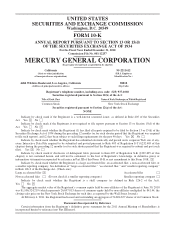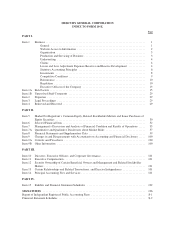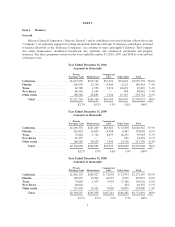Mercury Insurance 2010 Annual Report Download - page 19
Download and view the complete annual report
Please find page 19 of the 2010 Mercury Insurance annual report below. You can navigate through the pages in the report by either clicking on the pages listed below, or by using the keyword search tool below to find specific information within the annual report.
The nominal average maturity of the overall bond portfolio was 11.8 years (11.3 years including all short-
term instruments) at December 31, 2010, and is heavily weighted in investment grade tax-exempt municipal
bonds. Fixed maturity investments purchased by the Company typically have call options attached, which further
reduce the duration of the asset as interest rates decline. The call-adjusted average maturity of the overall bond
portfolio was 6.3 years (6.0 years including all short-term instruments) related to holdings which are heavily
weighted with high coupon issues that are expected to be called prior to maturity. The modified duration of the
overall bond portfolio reflecting anticipated early calls was 4.7 years (4.5 years including all short-term
instruments) at December 31, 2010, including collateralized mortgage obligations with a modified duration of 2.2
years and short-term bonds that carry no duration. Modified duration measures the length of time it takes, on
average, to receive the present value of all the cash flows produced by a bond, including reinvestment of interest.
As it measures four factors (maturity, coupon rate, yield, and call terms) which determine sensitivity to changes
in interest rates; modified duration is considered a better indicator of price volatility than simple maturity
alone. The longer the duration, the more sensitive the asset is to market interest rate fluctuations.
Equity holdings consist of non-redeemable preferred stocks and common stocks on which dividend income
is partially tax-sheltered by the 70% corporate dividend received deduction. At year end, 88.1% of short-term
investments consisted of highly rated short-duration securities redeemable on a daily or weekly basis. The
Company does not have any direct equity investment in subprime lenders.
Investment Results
The following table presents the investment results of the Company for the most recent five years:
Year Ended December 31,
2010 2009 2008 2007 2006
(Amounts in thousands)
Average invested assets at cost(1) .............. $3,121,366 $3,196,944 $3,452,803 $3,468,399 $3,325,435
Net investment income:
Before income taxes .................... 143,814 144,949 151,280 158,911 151,099
After income taxes ..................... 128,888 130,070 133,721 137,777 127,741
Average annual yield on investments:
Before income taxes .................... 4.6% 4.5% 4.4% 4.6% 4.5%
After income taxes ..................... 4.1% 4.1% 3.9% 4.0% 3.8%
Net realized investment gains (losses) after income
taxes(2)(3) ................................ 37,108 225,189 (357,838) 13,525 10,033
Net increase in unrealized gains on investments
after income taxes(3) ...................... $ — $ — $ — $ 10,905 $ 3,103
(1) Fixed maturities and short-term bonds at amortized cost and equities and other short-term investments at
cost.
(2) Includes investment impairment write-down, net of tax benefit, of $14.7 million in 2007 and $1.3 million in
2006. 2007 also includes $1.3 million gain, net of tax, and $0.9 million loss, net of tax benefit, related to the
change in the fair value of trading securities and hybrid financial instruments, respectively.
(3) Effective January 1, 2008, the Company adopted the fair value option with changes in fair value reflected in
net realized investment gains or losses in the consolidated statements of operations.
Competitive Conditions
The Company operates in the highly competitive property and casualty industry subject to competition on
pricing, claims handling, consumer recognition, coverage offered and other product features, customer service,
and geographic coverage. Some of the Company’s competitors are larger and well-capitalized national
companies which have broad distribution networks of employed or captive agents.
9
























